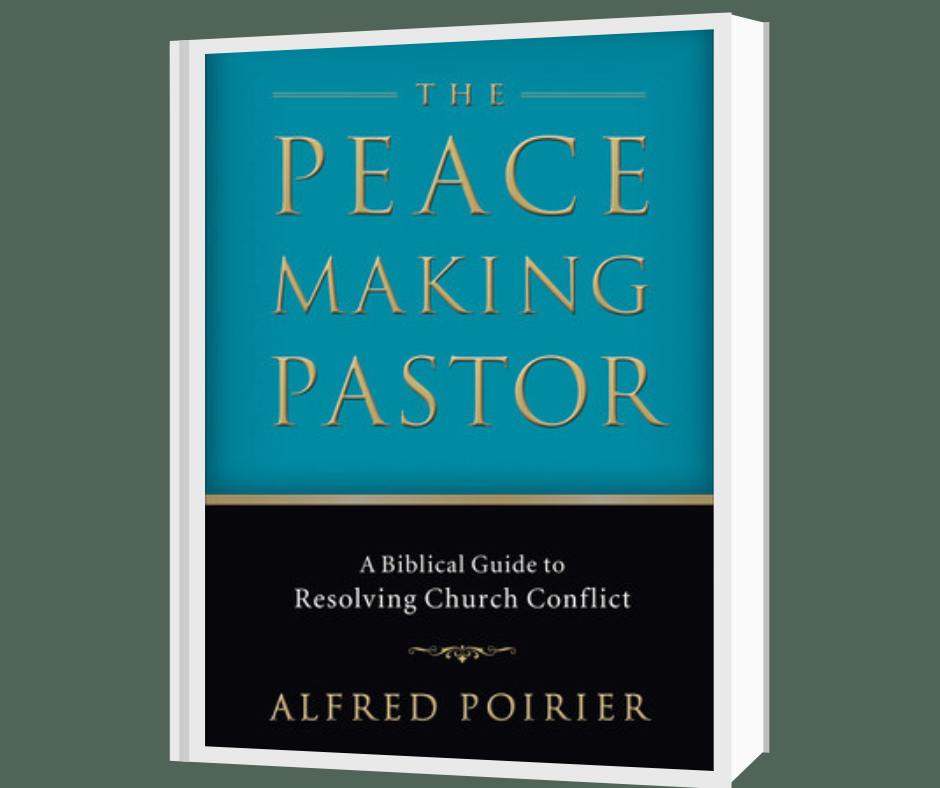Book Reviews
The Peacemaking Pastor: A Biblical Guide to Resolving Church Conflict, by Alfred Poirier | Review by Rosa Byler

Alfred Poirier’s introduction is forthright: “Christ is the reason many enter the pastorate. Conflict is the reason many leave.” The frequency of church conflicts should not surprise us, he says, as much as the fact that “churches, Bible colleges, and seminaries alike provide little if any pastoral training in how to address these conflicts.” (9-10) The Peacemaking Pastor lays a solid biblical/theological foundation for peacemaking and makes a convincing case for pastors to become more intentionally involved.
While acknowledging the value of communication/listening skills and such methods as interest-based negotiation, Poirier differentiates between biblical peacemaking and alternative dispute resolution (ADR). ADR bases mediation on sociological and psychological definitions of conflict; biblical peacemaking frames conflict in terms of sinful heart responses and finds hope only in a renewed vision of the gospel.
Who should be better prepared to present that gospel of peace than a pastor ordained for the purpose? Poirier identifies numerous hindrances to pastors’ resolving conflict in biblical ways. Surrounded by an ungodly and litigious culture, unsuspecting Christians default to secular psychological methods and a court-of-law mentality. He confesses his own lack of enthusiasm for dealing with conflict, labeling it heresy (Docetism, denying that Jesus came in the flesh, produces functional unbelief that He relates to and helps human struggles) and tells surprising stories of pastors prioritizing other tasks over the ministry of reconciliation.
The church is about the ministry of reconciliation (God to man; man to man), and Poirier argues that peacemaking should be seen as a constructive life posture instead of just a corrective remedy for crises. Quarreling members are brothers and sisters in Christ rather than merely “individuals with competing interests.” (14) Foundational doctrines of the faith must be recovered and allowed to inform peacemaking. (For example, how does understanding God’s sovereignty shape our response to conflict?) Churches must expand their definition of “discipline” to include the entire Christian experience (discipleship), not just the extremes of membership suspension or excommunication.
The first several chapters outline the most common causes of church conflict: divided allegiances, problems with authority, and “substituting man-made boundary markers for the gospel of Christ as the real basis of fellowship.” (33) Anyone familiar with Ken Sande’s principles will recognize the Slippery Slope diagram, with attack and escape responses on either side of the peacemaking options in the center. The same sinful heart dynamics lie beneath most controversies; Poirier uses typical marriage conflicts as teaching examples.
The next chapters focus on the character and nature of the Triune God, who not only created a harmonious world but also ordained conflict as He put enmity between the serpent and mankind. (The tension between this concept and the statement that “conflict, sin, disorder, and confusion are aberrations in God’s good creation” [74] will provoke the reader to intense thought and scripture-searching.) Conflict is undoubtedly the storyline of the Bible, and the Messiah’s redemptive work can be described as “conflict work.”
To be biblical, peacemaking must be grounded in the biblical theology of redemption. Human relationships are designed to image redemption, which uses the language of sonship and love. Starting from Jesus’ blessing of peacemakers as sons of God, Poirier turns to both Old and New Testament passages describing God as Father and His people as family. Such familial terms as adoption, birth, and household are particularly common in the NT. Failure to demonstrate those family ties of love and affection in conflict leaves churches without a credible witness to the gospel’s transforming power.
The longest section of the book discusses Christian responses to conflict. Poirier examines the specific peacemaking practices of confession, forgiveness, negotiation, mediation, and arbitration, linking them to the scriptural foundation of the previous chapters. All pastors teach and practice these to some extent; yet confessions can be inadequately specific, forgiveness inappropriately extended, and negotiations competitive and self-seeking. Abundant illustrations from Scripture and personal experience enhance his practical teaching.
Poirier’s own congregation successfully navigated a situation that could easily have split the church, and the last chapter recounts this testimony to the efficacy of biblical peacemaking. It is not a tale of unqualified triumphs and steady upward progress; there were mistakes and messy consequences, ignorance and misunderstanding, miscommunication and panic. Yet the leaders’ commitment to unity and their clear gospel trajectory after every setback resulted in the ultimate strengthening of the church, with no loss of membership and an unexpected witness to the surrounding community.
Written years before the recent pandemic, controversial election, and explosion of public contentiousness, this excellent book was designed as a potential seminary textbook but has value for all believers. Poirier’s experiences as the longtime pastor of a church and member of Peacemaking Ministries’ board contribute to his credibility in this field. While the writing style is uncomplicated and readable, be aware that chapters are lengthy, solidly constructed, and dense.